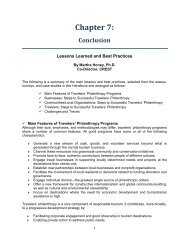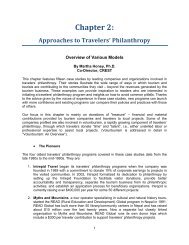Travelers' Philanthropy Handbook - Center for Responsible Travel
Travelers' Philanthropy Handbook - Center for Responsible Travel
Travelers' Philanthropy Handbook - Center for Responsible Travel
You also want an ePaper? Increase the reach of your titles
YUMPU automatically turns print PDFs into web optimized ePapers that Google loves.
5. What factors or circumstances would make donating to this Fund easier <strong>for</strong> a person likeyou?6. What factors or circumstances would make donating to this Fund more difficult <strong>for</strong> a personlike you?As guests responded to each question, I followed up with in-depth probing to ensure that eachperson had exhausted the range of responses that were salient to each question. Only theresults corresponding to the first four questions are reported here since guests’ responses toquestions 5 and 6 revealed no major facilitators or barriers pertaining to the ease or difficulty ofmaking a donation (other than needing to know where and when a donation could be made). Inaddition, it is from their aggregate replies to the first four questions that the philanthropic motiveof prospective donors conspicuously emerges.When travelers mentioned the reasons they would engage in philanthropy (i.e., the positiveconsequences they thought would result from donating), extrinsic reasons such as getting a taxdeduction were rarely mentioned. In fact, tax deductions were almost never mentioned (Table1). Instead, these travelers stressed the personal satisfaction that comes from knowingtheir travel has made a positive difference in the place; and they stressed thegratification they would get years later when something triggers their memory of theplace, and with it, the recognition that the place is somehow better off simply becausethey have been there. Needless to say, such a line-item will not be found on an IRS Form1040 or its tax <strong>for</strong>m counterpart in any other country. In addition, many guests said they wouldbe more inclined to donate if they fully trusted the Fund’s management and had confidence thatmost or all of their money would actually be directed to doing the good things they envisionedwhen they donated.Table 1. Reasons travelers cite <strong>for</strong> donating to a philanthropy fund.• I’ll have the satisfaction of knowing that I helped protect a special place (87%)• I’ll know that my $$ went to specific concrete projects that I really care about (86%)• I’ll know that my $$ made the difference I wanted to make. I’ll see the difference.(85%)• I’ll help to protect this place against specific threats (85%)• The fund will be managed wisely. It is credible and trustworthy (80%)• I can trust the organization to use my $$ the way I intend (80%)• I’ll feel good every time I remember this trip or tell other people about it (73%• I’ll feel good knowing my trip here has done something good (72%)• My $$ will help not just the environment but also the people who live here (45%)• There will be monitoring and en<strong>for</strong>cement of regulations (40%)• People here will learn to safeguard their own environment (25%)• I’ll get a tax deduction (2%)• I’ll get a voucher towards a future trip (>1%)Percentages do not add to 100 because respondents could indicate more than one reason.When travelers were asked about the down side of contributing (that is, the negativeconsequences that might ensue and their doubts and hesitations about donating), the core oftheir reticence stemmed mainly from uncertainty about how their money would be used orwhether it was needed. (Table 2). According to these findings, prospective donors want to be143















